The jewelry market has traditionally been driven by the allure of luxury, craftsmanship, and exclusivity. For high-net-worth individuals (HNWIs), fine jewelry has long been seen as a symbol of status, wealth, and sophistication. However, as the world changes and consumer preferences evolve, so too does the way HNWIs approach their jewelry purchases. One significant shift in recent years is the increasing demand for personalized and bespoke jewelry, as these affluent consumers seek pieces that are not only luxurious but also deeply meaningful and unique to their individual tastes and lifestyles.
This article will explore how the jewelry consumption trends of high-net-worth individuals are shifting towards personalized customization, the factors driving this transformation, and what the future of high-end jewelry might look like in this new era of bespoke luxury.
1. The Rise of Personalized Jewelry for High-Net-Worth Individuals
A. A Move Beyond Traditional Luxury
For decades, the jewelry market for HNWIs has been centered around well-known luxury brands such as Cartier, Tiffany & Co., Van Cleef & Arpels, and Bvlgari. These brands have long been associated with timeless luxury, impeccable craftsmanship, and iconic designs. However, in recent years, many affluent consumers have started to shift their focus from mass-produced luxury pieces to jewelry that speaks more personally to their tastes, values, and life stories.
While traditional luxury jewelry still holds a prominent place in the market, there is a noticeable trend toward customized pieces. HNWIs are increasingly seeking jewelry that reflects their personal identity rather than purchasing items simply for brand recognition. This desire for uniqueness and self-expression is causing a significant shift in how these consumers view their jewelry investments.
B. The Appeal of Bespoke and One-of-a-Kind Creations
Bespoke jewelry offers HNWIs the opportunity to own something that is truly one of a kind—no one else will own the same piece. This uniqueness is an extremely attractive quality for individuals who have already acquired the best of what luxury brands offer and are now looking for something more meaningful.
The process of creating bespoke jewelry, which often involves working closely with skilled designers and craftsmen, is viewed as an art form in itself. The personal involvement in the creation process makes the end product even more special, as it carries with it a deep connection to the individual’s preferences and desires.
For many HNWIs, bespoke jewelry allows them to celebrate personal milestones, such as weddings, anniversaries, or the birth of a child, in a way that feels more intimate and significant than purchasing a mass-market luxury item. As a result, personalization has become a major trend in the high-end jewelry market, with many brands now offering customization options to cater to this demand.
2. Factors Driving the Shift Towards Customization
A. The Desire for Individuality and Self-Expression
One of the main reasons why high-net-worth individuals are moving toward personalized jewelry is the growing desire for individuality and self-expression. The concept of personalization in luxury goods is not new, but it has taken on new significance in the digital age, where consumers are increasingly looking to stand out and define their personal style in unique ways.
For HNWIs, owning something that is exclusive and customized is a way to differentiate themselves from others. Jewelry has always been a way for people to express their personal taste, but today, many consumers are less interested in the idea of simply wearing the same pieces as everyone else. Customization offers a way to take this to the next level, allowing affluent individuals to create jewelry that is entirely theirs.
In addition to the aesthetic aspect, customized jewelry also allows for the inclusion of meaningful elements—such as initials, birthstones, or special engravings—that represent important life events. These personal touches make the piece feel more connected to the individual, further increasing its sentimental value.
B. Influence of Social Media and Celebrity Culture
The rise of social media and the influence of celebrities and influencers on platforms like Instagram and Pinterest has also fueled the demand for unique and personalized jewelry. Celebrities, royals, and influencers are often seen wearing one-of-a-kind pieces or showcasing jewelry that has been specifically designed for them. As a result, their followers—many of whom are affluent consumers—are increasingly looking to replicate this sense of exclusivity.
Influencer culture and the widespread sharing of personal milestones online have made personalized jewelry even more desirable. Bespoke designs are now often showcased on social media, giving affluent individuals the ability to share their unique creations with a broader audience. Whether it’s a customized engagement ring or a piece commemorating a personal achievement, the ability to share a one-of-a-kind jewelry piece online adds another layer of exclusivity and appeal for HNWIs.
C. The Desire for Investment and Legacy Pieces
Many high-net-worth individuals are not only purchasing jewelry for aesthetic pleasure but also as a long-term investment or legacy piece. Customized jewelry provides an opportunity to create pieces that are not only valuable today but will also stand the test of time and be passed down through generations. These pieces often hold greater sentimental and historical value because they are tied to specific personal experiences or family stories.
Bespoke jewelry can be designed with a focus on enduring quality, using rare gemstones, high-quality metals, and intricate designs that elevate the piece’s value. This kind of jewelry can become an heirloom—a symbol of wealth, status, and family heritage that is passed down through generations, further enhancing its investment appeal.
D. Technological Advancements in Jewelry Design
Technological advancements in the jewelry industry, particularly the use of 3D printing and computer-aided design (CAD), have made it easier than ever to create customized jewelry pieces. These technologies allow designers to bring even the most complex and intricate designs to life with a high degree of precision, making personalized jewelry more accessible to high-net-worth individuals.
In the past, creating a bespoke piece of jewelry often required significant time and effort, and could only be done by highly skilled artisans. Today, thanks to the latest design technologies, customization can be achieved more efficiently, without compromising on quality. Additionally, the advent of virtual reality (VR) and augmented reality (AR) tools has allowed customers to visualize and experiment with their jewelry designs before committing to a final product, adding an element of interactivity and further enhancing the bespoke experience.

3. The Impact of Personalized Jewelry on Luxury Brands
A. Leading Luxury Brands Embrace Customization
Recognizing the growing demand for personalization, many of the world’s top jewelry brands have begun to offer customization options for their customers. Companies like Cartier, Tiffany & Co., Van Cleef & Arpels, and Bvlgari have introduced bespoke services, allowing customers to personalize everything from engagement rings to necklaces, bracelets, and earrings.
For instance, Tiffany & Co. offers a custom design service where customers can work with their expert designers to create one-of-a-kind jewelry pieces. Similarly, Cartier has a Bespoke service that lets customers personalize pieces by selecting stones, metals, and designs that reflect their individual tastes.
These luxury brands are recognizing that personalization is not just a passing trend but a major driver of growth in the high-end market. By offering custom designs, they are able to meet the demands of HNWIs who are looking for more than just off-the-shelf luxury products. The move toward personalization also helps brands build stronger relationships with their customers, further increasing customer loyalty.
B. The Emergence of Independent Jewelers
In addition to the major luxury brands, independent and boutique jewelry designers are capitalizing on the demand for bespoke jewelry. These smaller designers often offer highly personalized services and cater specifically to HNWIs seeking unique pieces. The personalized nature of their offerings allows them to stand out in a crowded market, giving them an edge over larger brands that may not be able to offer the same level of customization.
Independent jewelers also benefit from the rise of digital platforms, which allow them to reach a wider audience and showcase their bespoke designs to potential clients around the world. This is particularly important in attracting international high-net-worth consumers who are seeking exclusive and unique pieces.
4. The Future of Personalized Jewelry for High-Net-Worth Individuals
As the demand for personalized and bespoke jewelry continues to grow, it is clear that this trend is not just a passing phase but a lasting shift in the jewelry market. The appeal of individuality, exclusivity, and emotional connection will continue to drive affluent consumers toward customized jewelry options.
In the future, we can expect to see even more innovative and interactive ways for consumers to create and design their jewelry. The integration of AI and machine learning into the customization process could lead to even more personalized recommendations and design possibilities, while blockchain technology could help authenticate and secure the provenance of high-value pieces.
Additionally, the focus on sustainability and ethical sourcing will likely become an important part of the personalized jewelry experience. HNWIs who prioritize ethical and eco-friendly practices will seek jewelry that reflects their values and aligns with their commitment to social and environmental responsibility.
Conclusion: A New Era of Jewelry Consumption
High-net-worth individuals are increasingly turning to personalized and bespoke jewelry as a way to express their individuality, create meaningful connections with their purchases, and invest in long-lasting heirlooms. This shift reflects a broader trend in the luxury market, where consumers are seeking more personalized experiences and customized products that align with their unique lifestyles and values.
As the demand for customization continues to rise, luxury jewelry brands—both large and small—are embracing the opportunity to cater to these preferences. The future of jewelry consumption for high-net-worth individuals will likely be defined by personalized luxury, with customers looking for pieces that reflect their personal stories, tastes, and beliefs.
In this new era, the focus on bespoke and personalized jewelry will not only transform the way HNWIs purchase jewelry but also redefine the concept of luxury itself.

















































